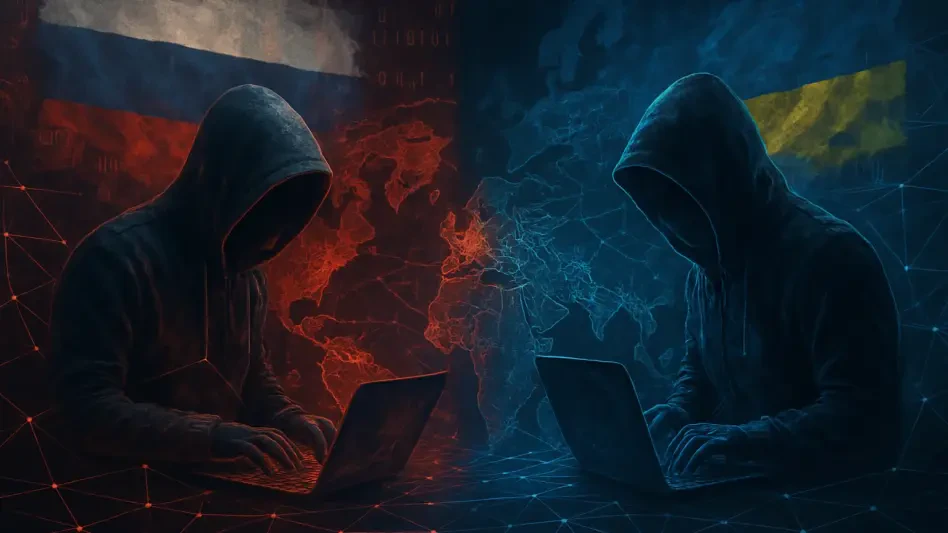In the evolving landscape of modern warfare, a chilling new front has emerged where artificial intelligence (AI) serves as a powerful tool in the hands of Russian hackers targeting Ukraine, amid an ongoing conflict that has seen a staggering increase in cyber incidents. Reports from Ukraine’s State Service for Special Communications and Information Protection (SSSCIP) reveal that AI plays a central role in amplifying the sophistication and scale of these attacks. The integration of advanced technology into malicious campaigns marks a significant shift, transforming traditional cyber threats into adaptive, hard-to-detect operations. This development not only challenges Ukraine’s digital defenses but also raises critical questions about the future of cybersecurity in conflict zones. As Russian hackers leverage AI to craft malware and phishing schemes, the stakes for critical infrastructure and national security have never been higher, setting the stage for a deeper exploration of this alarming trend.
Escalating Cyber Threats in Conflict
AI’s Role in Advanced Malware Development
The surge in cyber incidents targeting Ukraine, as documented by the SSSCIP, underscores a troubling evolution in warfare tactics, with AI at the forefront of this transformation. In the first half of this year, over 3,000 cyber incidents were recorded, a notable rise from the previous period, reflecting the growing reliance on AI to develop sophisticated malware. One striking example is the PowerShell data-stealing malware known as WRECKSTEEL, deployed by the group UAC-0219 against state administration bodies and critical infrastructure. Unlike earlier methods that primarily used AI for generating phishing content, this shift to malware creation allows attackers to craft threats that can adapt and potentially bypass conventional security measures. The ability of AI to enhance the complexity of these tools poses a significant challenge for defenders, who must now contend with rapidly evolving digital threats that exploit vulnerabilities with unprecedented precision.
Beyond the creation of individual malware strains, the broader implications of AI in cyber warfare are becoming increasingly evident. Russian hackers are not merely experimenting with technology but are strategically deploying it to target key sectors such as local authorities and military entities. This targeted approach indicates a deliberate intent to destabilize Ukraine’s operational capabilities at multiple levels. The SSSCIP data highlights that while attacks on government and energy sectors have seen a slight decline, the focus on defense and administrative bodies has intensified, suggesting a recalibration of priorities by threat actors. As AI continues to enable the automation and scalability of these attacks, the line between digital and physical warfare blurs, creating a hybrid threat environment where technology amplifies the impact of each malicious operation. This trend demands urgent attention to bolster defenses against such innovative and persistent adversaries.
Exploiting Legitimate Platforms for Stealth
Another alarming tactic in the arsenal of Russian hackers is the exploitation of trusted online platforms to facilitate their attacks, a method that complicates detection and mitigation. Services like Dropbox, Google Drive, OneDrive, Telegram, and Cloudflare Workers are increasingly abused to host malware, create phishing pages, or exfiltrate stolen data. This approach, while not entirely new, has grown in frequency and sophistication, leveraging the inherent trust users place in these legitimate tools. The SSSCIP notes that such tactics make it harder for security systems to flag malicious activity, as traffic to and from these platforms often appears benign at first glance. This stealthy integration of everyday technology into cyber campaigns targeting Ukraine’s critical sectors reveals a calculated effort to exploit familiarity and bypass traditional safeguards.
The diversity of sectors under attack further illustrates the comprehensive nature of this strategy, with defense forces, local governments, and infrastructure providers bearing the brunt of these efforts. Specific campaigns by groups like UAC-0218 and UAC-0226 often involve deceptive mechanisms such as booby-trapped RAR archives or fake websites mimicking trusted entities. These operations are designed to distribute stealers and backdoors with names like HOMESTEEL and GIFTEDCROOK, aimed at extracting sensitive information. The reliance on legitimate platforms not only enhances the reach of these attacks but also underscores the adaptability of threat actors in navigating the digital landscape. As attackers refine their use of such services, the challenge for cybersecurity experts lies in developing detection methods that can distinguish between legitimate and malicious use without disrupting essential online functionalities.
Strategic Integration of Cyber and Kinetic Warfare
Synchronized Attacks for Maximum Disruption
A defining characteristic of Russia’s cyber strategy against Ukraine is the seamless integration of digital attacks with physical battlefield actions, embodying a hybrid warfare approach. The notorious Sandworm group, identified as UAC-0002, has been at the forefront of this tactic, targeting critical sectors like energy, defense, and internet service providers. By synchronizing cyberattacks with kinetic operations, these threat actors aim to maximize disruption, creating chaos that hampers Ukraine’s ability to respond effectively on multiple fronts. The SSSCIP reports highlight how such coordinated efforts amplify the impact of each strike, whether it’s disabling infrastructure through malware or undermining communication during physical engagements, revealing a calculated intent to weaken national resilience.
This strategic alignment extends beyond mere timing, as it reflects a deep understanding of how digital vulnerabilities can exacerbate physical damage in conflict zones. For instance, disabling power grids or communication networks during military offensives can cripple response mechanisms, leaving critical systems exposed. The use of AI in crafting these cyberattacks adds another layer of complexity, enabling rapid adaptation to defensive countermeasures. As groups like APT28 (UAC-0001) exploit software vulnerabilities in tools like Roundcube and Zimbra for zero-click attacks, the potential for widespread disruption grows. These incidents, often involving credential theft and email redirection, demonstrate how cyber operations can directly support broader military objectives, necessitating a reevaluation of how cybersecurity intersects with national defense strategies in modern warfare.
Adapting Defenses to Evolving Threats
As the sophistication of cyber threats continues to escalate, the need for adaptive and proactive defense mechanisms becomes increasingly urgent for Ukraine. The integration of AI into malware and phishing campaigns by Russian hackers means that traditional security protocols are often outpaced by the speed and adaptability of these attacks. Cybersecurity experts must prioritize the development of AI-driven defense tools capable of predicting and neutralizing threats before they inflict significant harm. Collaboration between government agencies, private sector entities, and international allies is also critical to share intelligence and resources, ensuring a unified front against such multifaceted dangers. The focus must shift toward real-time monitoring and response systems to address the dynamic nature of these hybrid warfare tactics.
Looking back, the rapid rise in cyber incidents earlier this year served as a stark reminder of the evolving threat landscape that Ukraine navigated with limited resources. The persistent targeting of diverse sectors, from military to energy, underscored the comprehensive scope of Russian cyber aggression. Reflecting on these challenges, it became evident that future strategies needed to emphasize resilience through technological innovation and international cooperation. Building robust frameworks to counter AI-enhanced threats was a key lesson, as was the importance of educating critical infrastructure operators about emerging risks. Moving forward, investing in advanced detection capabilities and fostering global partnerships will be essential steps to mitigate the impact of such sophisticated cyber weapons, ensuring that defenses evolve in tandem with the threats they aim to neutralize.








